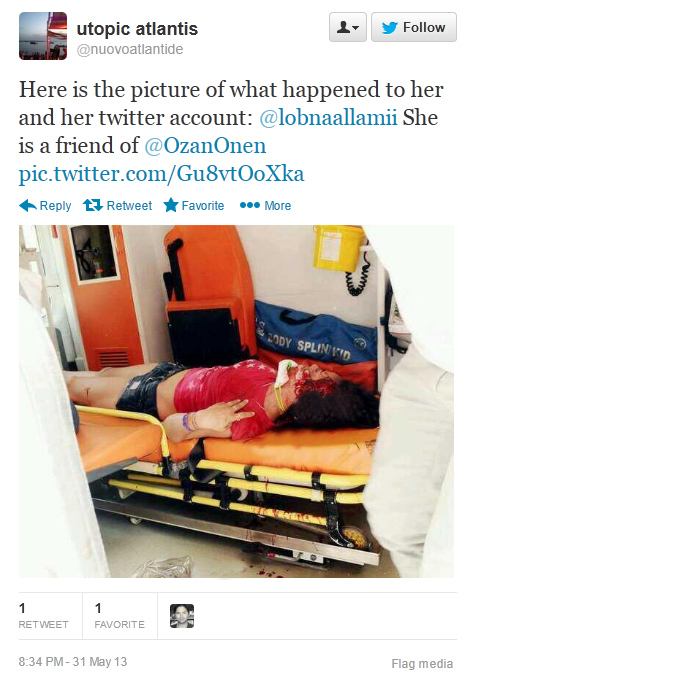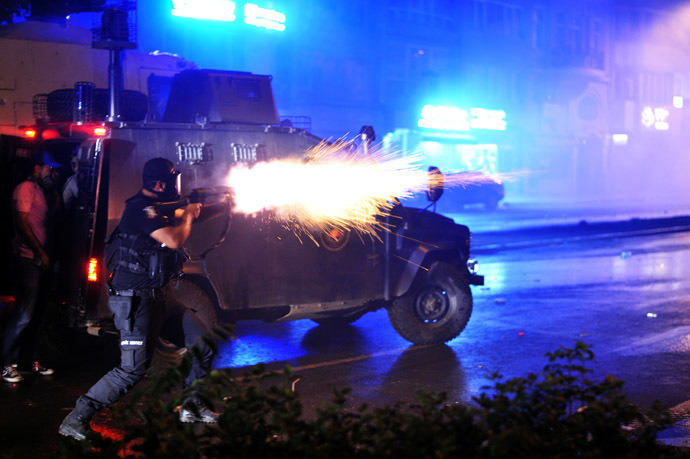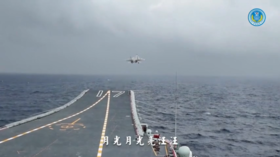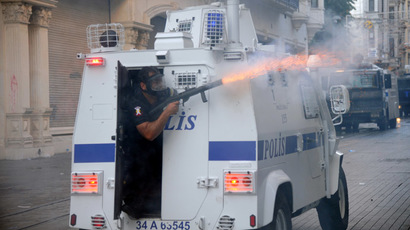‘Direct fire’: HRW urges Turkey to end ‘incorrect, unlawful’ teargas use, cites victims (GRAPHIC PHOTOS)

Turkish police fired teargas canisters at close range and directly at people during the Gezi Park protests causing serious injuries, says a report by the Human Rights Watch. Those hit by canisters lost eyes and received life threatening skull fractures.
The Turkish authorities “should immediately issue improved
guidelines on when and how teargas may be used that included a
prohibition on firing teargas canisters in confined areas or
directly at people,” Human Rights Watch (HRW) said.
The report titled “Turkey: End Incorrect, Unlawful Use of
Teargas,” which has been published on the group’s website,
also calls to “strictly enforce” such policies, and hold
non-compliant police officers accountable.
“Teargas canisters can inflict serious ‒ even life threatening
‒ wounds when fired directly at demonstrators, and that happened
over and over again at Gezi Park,” said Emma Sinclair-Webb,
senior Turkey researcher at Human Rights Watch. “The police
and their commanders who used these canisters in such an
irresponsible way should be held to account for inflicting
unnecessary harm and endangering lives.”
At least 11 people lost an eye after being hit by a teargas
canister or a plastic bullet in Turkey up to June 27, says the
statement by the Medical Association quoted in the report. Dozens
of others received serious head or upper body injuries.

Interviews of victims, witnesses, lawyers, and medical personnel
cited in the report suggest that such injuries were caused by
police firing tear gas from launchers directly at people, often
at close range. The “scale and consistency” of such
accounts point to “a clear pattern of misuse of teargas by
Turkey’s police force,” HRW states.
Ten accounts of victims who were seriously injured in police tear
gas attacks have been documented in the report. Those include a
university lecturer who lost his eye as he was walking down the
street in Istanbul’s rioting Besiktas district; a long time
Taksim square protester who got an 8 centimeter skull fracture
and a psychological trauma; a woman taking part in a peaceful
sit-in protest who was shot unconscious, had her skull fractured,
and was held in an induced coma for 24 days after; as well as a
14-year-old boy apparently caught in close-range police fire near
his family home, who suffered from intracranial bleeding and has
remained in critical condition for over four weeks.
Shooting directly at people ‘a systematic policy’
Burak Unveren, 31, who lost his eye in Besiktas on June 1 after being fired at by a police officer some 40 meters away, told HRW he was “almost sure that this act of violence was deliberate.” The police fired tear gas canisters horizontally, rather than trying to launch them at a 45 degree angle, he said. While in hospital, he also met several people “shot in their faces in the same way.”
“Shooting in this way directly at people is a systematic
policy of the Turkish police,” Unveren believes.
YTÜ Öğretim Görevlisi Burak Ünveren'e yardım eden arkadaşı arıyoruz arkadaşlar. Lütfen RT yapalım! pic.twitter.com/wLcdhreV7B
— Serhan Sayar (@serhansayar) June 4, 2013
Okan Gocer, 23, who was taking part in a peaceful June 1 protest
several hundred meters from Taksim Square, said he was telling
people to stay and not to be intimidated by a heavy police
presence, when a tear gas attack was launched without warning.
“They just popped out. There were no warnings. They just
attacked right away. There were many shots ‒ they just opened
fire. One of them hit me in the head. I think the police might
have targeted me because I encouraged people to stay,” Gocer
said.
Gaz fişeğiyle vurulan ve okmeydanı SSK'da bulunan Okan Göçer ve Duran Akbaş Berkin'e destek oluyorlar #uyanberkinpic.twitter.com/bgLi3Gn03c
— Efkan Bolaç (@efkanbolac) June 29, 2013
The teargas canister that struck the protester rendered him unconscious and caused a 7-8 centimeter fracture to his skull. Gocer had to undergo emergency surgery and was kept in an induced coma for more than two weeks. Nearly a month after the incident he said he still struggled with the pain, and that he was no longer a “cheerful” person “full of hope and optimism” that he used to be.

‘There was no place to hide’
Secil Sucu, 21, a female protester who witnessed an earthmover
used against the police vehicle in Istanbul’s Besiktas district,
was trying to leave the area of violent protests, but was blocked
by the tear gas firing police in one of the side streets.
“We were blocked in. When I turned to see how far away the
police were, one policeman rushed toward me, aiming at me with
his teargas launcher. He was perhaps 10 meters away. There was no
place for me to hide so the only thing I could do was to try to
protect my head. I had started to turn away when the teargas
canister hit my goggles, breaking them. My head was ringing and
then all went quiet and white. I thought that this is how people
die,” Sucu said.
cc: @CassandraRules@raptorexplosion MT @SeydaGoncu: Seçil Sucu 2 temmuzda besiktasta bu hale getirildi pic.twitter.com/rLE6nUL1PO
— Çapulcular Şubesi (@superbranch) June 10, 2013
Later in the hospital, Sucu was told she had a six-centimeter
skull fracture and that it would take her months to recover. She
now admits to having “panic attacks” and being afraid to
stay at home alone.
For Lobna Allamii, 34, the life changed forever after the brutal
crackdown on peaceful sit-in protest in Taksim square on May 31.
Following the sudden police attack the woman was found lying on
the ground unconscious and having seizures.
Lobna Allamii a student at Orta Doğu Teknik Üniversitesi peacefully protesting at Taksim Square shot by police pic.twitter.com/S4O8Aryhvr
— Rupert Ferguson (@RupertTheswarm) June 17, 2013
Allamii was operated on twice after the doctors found a fracture
in her skull, a severe injury on the left side of her head, and
intracranial bleeding on the right side. The woman was kept in an
induced coma for 24 days, had her right arm partially paralyzed,
and her speech and eyesight damaged.
According to the HRW report, the circumstances and the nature of
Allamii’s injuries “point to a teargas canister fired from
close range as the cause.”

A 14-year-old boy, Berkin Elvan, who sustained serious head
injuries and has remained in critical condition for more than
four weeks, was not taking part in protests, but got caught in a
police attack in Istanbul’s Okmeydani neighborhood on June 16.
According to accounts by family members and friends, the boy went
out to buy bread from a nearby bakery when the police started
firing rounds of tear gas at the protesters that had gathered in
the area.
This is a photo of Berkin Elvan hit in the head by a tear gas canister. In critical condition.Stay Strong!#occupygezipic.twitter.com/dbryGa3BsE
— Ali Can S. (@Unidadpopular_a) June 16, 2013
Berkin’s lawyer has quoted a witness saying the police hit the
boy with a teargas canister from a distance of 10 to 15 meters.
Doctors of the hospital where Berkin was taken for surgery also
noted the boy smelled of gunpowder – another possible indication
of a close-range fire.
The boy’s case went viral in Turkey, and several actions in his
name have been organized, with a protest march for Berkin Elvan
taking place on Wednesday. He is still in intensive care.
Okmeydanı'nda Berkin Elvan için toplananlar ' umudun çocuğu Berkin Elvan' sloganı atıyor. pic.twitter.com/4r2UIa5YKb
— metehan tekeli (@m_tekeli) July 17, 2013
‘Police aim was to punish’
Having seen a large number of injuries resulting from teargas
canisters hitting people in the head and upper body, Dr. Hüseyin
Demirdiken of the Turkish Medical Association concluded that for
the Turkish police “the aim was not only to disperse the
crowds, but also to punish.”
Turkish journalist Ahmet Shik, who has been covering the Istanbul
protests, is said to have been “deliberately” hit by a
tear gas canister in the head, as noted by his friends on
Twitter. He said that although some policemen fired tear gas
canisters “in a correct way,” most others “fired them
directly at the protesters, often from close range.”
Reports said that the Turkish police used 130,000 teargas
canisters over three weeks in June. In total, Turkey imported 628 tons of tear gas and pepper spray
between 2000 and 2012, Turkish newspaper Sozcu reported, quoting
Customs and Trade Minister Hayati Yazici.
On July 16, 2013, the European Court of Human Rights ruled in the
case of Abdullah Yaşa and Others v. Turkey that “improper
firing of tear gas by Turkish police directly at protestors,
injuring a 13 year old, had violated human rights,” and
called for stronger safeguards to minimize the risk of death and
injury resulting from its use.
















